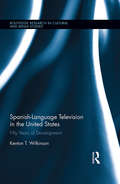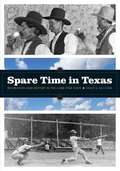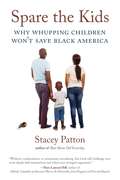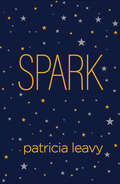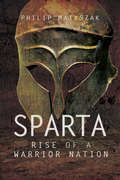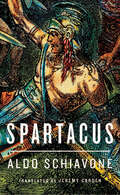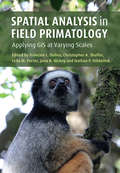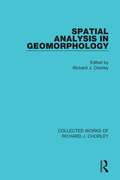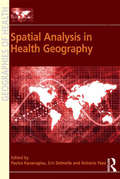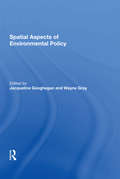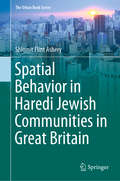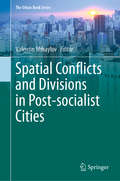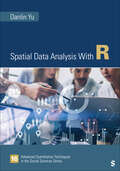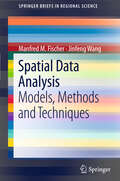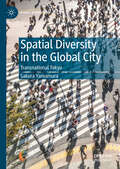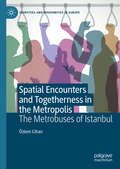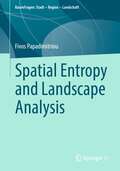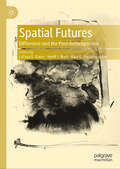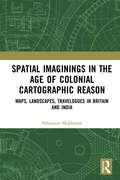- Table View
- List View
Spanish-Language Television in the United States: Fifty Years of Development (Routledge Research in Cultural and Media Studies)
by Kenton T. WilkinsonSince its introduction in the early 1960s, Spanish-language television in the United States has grown in step with the Hispanic population. Industry and demographic projections forecast rising influence through the 21st century. This book traces U.S. Spanish-language television’s development from the 1960s to 2013, illustrating how business, regulation, politics, demographics and technological change have interwoven during a half century of remarkable change for electronic media. Spanish-language media play key social, political and economic roles in U.S. society, connecting many Hispanics to their cultures of origin, each other, and broader U.S. society. Yet despite the population’s increasing impact on U.S. culture, in elections and through an estimated $1.3 trillion in spending power in 2014, this is the first comprehensive academic source dedicated to the medium and its history. The book combines information drawn from the business press and trade journals with industry reports and academic research to provide a balanced perspective on the origins, maturation and accelerated growth of a significant ethnic-oriented medium.
Spannungsfeld Flüchtlinge: Ein psychologischer Blick auf Engagierte und die Dialogkultur
by Christel KumbruckDieses Buch analysiert wissenschaftlich fundiert und zugleich allgemeinverständlich das Engagement von Menschen, die sich für die Aufnahme von Geflüchteten oder gegen die deutsche Flüchtlingspolitik engagieren, sowie ihre Motive, Emotionen, Denk- und Argumentationsweisen. Dabei werden psychologische Mechanismen, die ursächlich für die viel diskutierte Polarisierung unserer modernen Gesellschaft sind, deutlich. Erstmalig werden die tieferen Ursachen für bestehende Dialogbarrieren aufgespürt und mit psychologischen Modellen erklärt. Dabei decken die Autor*innen neben polarisierenden Dialogprozessen auch Gemeinsamkeiten beider Seiten auf und erarbeiten daraus Ansatzpunkte für Dialogchancen und eine Depolarisierung der Kommunikation. Neben der psychologischen Betrachtung erfolgt außerdem eine Einordung der beschriebenen, empirisch ermittelten Erkenntnisse in übergeordnete soziokulturelle Prozesse und gesellschaftliche Rahmenbedingungen. Auch hieraus werden Lösungsansätze, diesmal auf der Ebene von Politik und Gesellschaft, erarbeitet. Ein Buch für alle, die mehr Einblicke in das Flüchtlingsengagement haben wollen, die sich in Politik, Beratung, Coaching, Erziehung u.ä. aktiv an der Bewahrung einer Dialogkultur beteiligen, oder zumindest die (psychologischen) Mechanismen verstehen möchten, welche eine Polarisierung der Gesellschaft fördern."Dieses klare und differenzierte Arbeitsbuch ist eine großartige Hilfe zum Selbstdenken." - Prof. Aleida Assmann"Flucht und Migration werden Deutschland weiterhin vor Herausforderungen stellen. Dieses Buch zeigt nachvollziehbar, wie Wahrnehmungs-, Denk- und Handlungsweisen zu einer destruktiven Polarisierung beitragen können, aber auch welche Möglichkeiten wir alle haben, um der Falle vergifteter Kommunikation zu entgehen: ein hilfreiches Buch, um demokratischen Zusammenhalt zu stärken." - Prof. Eva Senghaas-Knobloch
Spare Time in Texas
by David G. MccombWhat do Texans' pastimes and recreations say about their characters? Looking at Texas history from a new angle, David McComb starts from the premise that how people spend their leisure time may well reveal more about their true natures and interests than the work they do or their family connections. In this innovative book, McComb traces the history of various types of recreation in Texas, gathering significant insights into the characters of Texans from the pleasures they have pursued. Reflecting the frontier origins of Texas, McComb starts with the recreations that were most popular with men in a crude, still-developing society--drinking, gambling, and whoring. He goes on to show how, as Texas became more civilized, so did its diversions. He describes how Texans have connected with nature in parks and zoos; watched football and baseball in great stadiums such as the Astrodome and Cotton Bowl; discovered the pleasure of reading in public and university libraries; and enjoyed radio, TV, movies, and live theater in places such as Houston's Alley Theatre. This recreational history reveals that Texans are open-minded and generous; that they respect the land; oppose prostitution but indulge in gambling and drinking; support racial and gender rights; love zoos; champion libraries; take pride in theatrical productions; and adore sports.
Spare the Kids: Why Whupping Children Won't Save Black America
by Stacey PattonA challenge to the cultural tradition of corporal punishment in Black homes and its connections to racial violence in AmericaWhy do so many African Americans have such a special attachment to whupping children? Studies show that nearly 80 percent of black parents see spanking, popping, pinching, and beating as reasonable, effective ways to teach respect and to protect black children from the streets, incarceration, encounters with racism, or worse. However, the consequences of this widely accepted approach to child-rearing are far-reaching and seldom discussed. Dr. Stacey Patton’s extensive research suggests that corporal punishment is a crucial factor in explaining why black folks are subject to disproportionately higher rates of school suspensions and expulsions, criminal prosecutions, improper mental health diagnoses, child abuse cases, and foster care placements, which too often funnel abused and traumatized children into the prison system.Weaving together race, religion, history, popular culture, science, policing, psychology, and personal testimonies, Dr. Patton connects what happens at home to what happens in the streets in a way that is thought-provoking, unforgettable, and deeply sobering. Spare the Kids is not just a book. It is part of a growing national movement to provide positive, nonviolent discipline practices to those rearing, teaching, and caring for children of color.
Spark
by Patricia LeavyProfessor Peyton Wilde has an enviable life teaching sociology at an idyllic liberal arts college--yet she is troubled by a sense of fading inspiration. One day an invitation arrives. Peyton has been selected to attend a luxurious all-expense-paid seminar in Iceland, where participants, billed as some of the greatest thinkers in the world, will be charged with answering one perplexing question. Meeting her diverse teammates--two neuroscientists, a philosopher, a dance teacher, a collage artist, and a farmer--Peyton wonders what she could ever have to contribute. The ensuing journey of discovery will transform the characters' work, their biases, and themselves. This suspenseful novel shows that the answers you seek can be found in the most unlikely places. It can be read for pleasure, is a great choice for book clubs, and can be used as unique and inspiring reading in qualitative research and other courses in education, sociology, social work, psychology, and communication.
Sparta: Rise Of A Warrior Nation
by Philip MatyszakThis cultural history of Ancient Sparta chronicles the rise of its legendary military power and offers revealing insight into the people behind the myths. The Spartans of ancient Greece are typically portrayed as macho heroes: noble, laconic, totally fearless, and impervious to pain. And indeed, they often lived up to this image. But life was not as simple as this image suggests. In truth, ancient Sparta was a city of contrasts. We might admire their physical toughness, but Spartans also systematically abused their children. They gave rights to female citizens that were unmatched in Europe until the modern era, meanwhile subjecting their conquered subject peoples to a murderous reign of terror. Though idealized by the Athenian contemporaries of Socrates, Sparta was almost devoid of intellectual achievement. In this revealing history of Spartan society, Philip Matyszak chronicles the rise of the city from a Peloponnesian village to the military superpower of Greece. Above all, Matyszak investigates the role of the Spartan hoplite, the archetypal Greek warrior who was feared throughout Greece in his own day and has since become a legend. The reader is shown the man behind the myth; who he was, who he thought he was, and the environment which produced him.
Spartacus (Revealing Antiquity)
by Aldo Schiavone“Separate[s] the man from the myth. . . . Both the newcomer and the experienced Roman historian will find a wealth of entertainment and information.” (Publishers Weekly)Spartacus (109?–71 bce) has been a source of endless fascination, the subject of myth-making in his own time, and of movie-making in ours. In this riveting, compact account, Aldo Schiavone rescues Spartacus from the murky regions of legend and brings him squarely into the arena of serious history.Schiavone transports us to Italy of the first century bce, where we encounter Spartacus, who is enslaved after deserting from the Roman army to avoid fighting against his native Thrace. Imprisoned in Capua and trained as a gladiator, he leads an uprising that will shake the empire to its foundations.While the grandeur of the Spartacus story has always been apparent, its political significance has been less clear. Often depicted as the leader of a class rebellion, Spartacus emerges here in a very different light: the commander of an army whose aim was to incite Italy to revolt against Rome and to strike at the very heart of the imperial system. Surprising, persuasive, and highly original, Spartacus challenges the lore and illuminates the reality of a figure whose achievements, and whose ultimate defeat, are more extraordinary and moving than the fictions we make from them.“A highly readable, interesting inquiry into a man and a movement.” —Booklist“You've seen the movie: now get the straight dope.” —Maclean’s magazine“[A] thought-provoking discussion of Spartacus and of first-century slavery.” —The Wall Street Journal“An intelligent, learned, and challenging account.” —New York Review of Books
Spas and Spa Visiting
by Ian RotherhamThe spa came into its own in Georgian Britain, with thousands flocking to take the waters at towns such as Bath, Cheltenham and Tunbridge Wells. As these towns grew, mixing with fashionable society became probably more important than seeking the benefits of bathing, which in any case often involved immersion in a mix of pure spa mineral water and an often filthy swill of dirt and sickly bodies. Ian Rotherham here traces the story of spa bathing, from Roman and medieval times, through its heyday in Georgian and Victorian Britain, to its demise in the twentieth century and its recent revival. Enlivened by a wealth of colorful illustrations, this book is a perfect introduction to changing attitudes to public bathing and health, and an excellent guide to the spa-related rise of some of Britain's most famous towns.
Spatial Analysis and Modeling in Geographical Transformation Process
by Rajesh Bahadur Thapa Yuji MurayamaCurrently, spatial analysis is becoming more important than ever because enormous volumes of spatial data are available from different sources, such as GPS, Remote Sensing, and others. This book deals with spatial analysis and modelling. It provides a comprehensive discussion of spatial analysis, methods, and approaches related to human settlements and associated environment. Key contributions with empirical case studies from Iran, Philippines, Vietnam, Thailand, Nepal, and Japan that apply spatial analysis including autocorrelation, fuzzy, voronoi, cellular automata, analytic hierarchy process, artificial neural network, spatial metrics, spatial statistics, regression, and remote sensing mapping techniques are compiled comprehensively. The core value of this book is a wide variety of results with state of the art discussion including empirical case studies. It provides a milestone reference to students, researchers, planners, and other practitioners dealing the spatial problems on urban and regional issues. We are pleased to announce that this book has been presented with the 2011 publishing award from the GIS Association of Japan. We would like to congratulate the authors!
Spatial Analysis for the Social Sciences
by David DarmofalMany theories in the social sciences predict spatial dependence or the similarity of behaviors at neighboring locations. Spatial Analysis for the Social Sciences demonstrates how researchers can diagnose and model this spatial dependence and draw more valid inferences as a result. The book is structured around the well-known Galton's problem and presents a step-by-step guide to the application of spatial analysis. The book examines a variety of spatial diagnostics and models through a series of applied examples drawn from the social sciences. These include spatial lag models that capture behavioral diffusion between actors, spatial error models that account for spatial dependence in errors, and models that incorporate spatial heterogeneity in the effects of covariates. Spatial Analysis for the Social Sciences also examines advanced spatial models for time-series cross-sectional data, categorical and limited dependent variables, count data, and survival data.
Spatial Analysis in Field Primatology: Applying GIS at Varying Scales
by Leila M. Porter Francine L. Dolins Christopher A. Shaffer Jena R. Hickey Nathan P. NibbelinkFrom foraging patterns in a single tree to social interactions across a home range, how primates use space is a key question in the field of primate behavioral ecology. Drawing on the latest advances in spatial analysis tools, this book offers practical guidance on applying geographic information systems (GIS) to central questions in primatology. An initial methodological section discusses niche modelling, home range analysis and agent-based modelling, with a focus on remote data collection. Research-based chapters demonstrate how ecologists apply this technology to study intensity of range use and travel routes, as well as to population-level questions; how GIS can help to assess the impact of logging, mining and hunting, as well as to inform primate conservation strategies. Offering best practice guidelines on cutting-edge technologies, this is an indispensable resource for any primatologist or student of animal behaviour.
Spatial Analysis in Geomorphology (Collected Works of Richard J. Chorley)
by Richard J. ChorleyOriginally published in 1972. This book covers from ‘linear’ statistical methods, regression and variance analysis to multivariate methods to wider spatial analytic techniques, in which a clear association is maintained between quantitative data and the spatial coordinates which locate them. The purpose of this volume is to highlight this coherent area of scholarship under the general headings of spatial point systems, networks, continuous distributions, partitioning and simulation. Seventeen authors from Britain and the United States have been brought together to produce a book whose attention is on the body of spatial techniques necessary to enable the building of dynamic spatial models of landforms which formed the keystone of much geomorphic work in future years.
Spatial Analysis in Health Geography (Geographies of Health Series)
by Pavlos Kanaroglou Eric DelmellePresenting current research on spatial epidemiology, this book covers topics such as exposure, chronic disease, infectious disease, accessibility to health care settings and new methods in Geographical Information Science and Systems. For epidemiologists, and for the management and administration of health care settings, it is critical to understand the spatial dynamics of disease. For instance, it is crucial that hospital administrators develop an understanding of the flow of patients over time, especially during an outbreak of a particular disease, so they can plan for appropriate levels of staffing and to carry out adaptive prevention measures. Furthermore, understanding where and why a disease occurs at a certain geographic location is vital for decision makers to formulate policy to increase the accessibility to health services (either by prevention, or adding new facilities). Spatial epidemiology relies increasingly on new methodologies, such as clustering algorithms, visualization and space-time modelling, the domain of Geographic Information Science. Implementation of those techniques appears at an increasing pace in commercial Geographic Information Systems, alongside more traditional techniques that are already part of such systems. This book provides the latest methods in GI Science and their use in health related problems.
Spatial Aspects of Environmental Policy
by Wayne GrayThere has been a recent explosion of research incorporating a spatial dimension in environmental and natural resource economics, where the spatial aspects of human behaviour or the natural environment make a crucial difference in the analysis and policy response to the problem. Much of this research has been driven by the growing availability of spatially explicit social science data and the development of tools and methodological advances to use these data. Collected in this volume are 24 key articles considering the reasons for spatial variation in policies, due to either efficiency or equity considerations, and the consequences of that spatial variation for both environmental and economic outcomes. These articles demonstrate that the failure to address spatial issues in the analysis can create two problems: (1) the analysis provides a poor basis for predicting actual behaviour that is specifically based upon spatial considerations, and (2) the analysis fails to provide a basis for designing spatially targeted policies that could lead to more efficient outcomes.
Spatial Behavior in Haredi Jewish Communities in Great Britain (The Urban Book Series)
by Shlomit Flint AsheryThis book focuses on the strict orthodox Jewish (Haredi) community, which comprises many sects whose communal identity plays a central role in everyday life and spatial organization. The research reveals and analyses powerful mechanisms of residential segregation acting at the apartment-, building- and near-neighbourhood levels. Identifying the main engines of spontaneous and organised neighbourhood change and evaluating the difficulties of liberalism dealing with non-autonomous individuals in the housing market sheds light on similar processes occurring in other city centres with diverse population groups. Highlighting the impact of various organisational levels on the spatial structure of the urban enclave, the book focuses on the internal dynamics of ethno-religious enclaves that emerge from three levels of action: (1) individuals' relationships with their own and other groups; (2) the community leadership's powers within the group and in respect of other groups; and (3) government directives and tools (e.g planning). The study examines how different levels of communal organisation are reflected in the residential patterns of four British communities: the Litvish communities of Golders Green and Gateshead, and the Hassidic communities of Stamford Hill and Canvey Island.
Spatial Conflicts and Conflictual Spaces: The Dynamics of Refiguration (The Refiguration of Space)
by Hubert Knoblauch Barbara Pfetsch Vivien SommerThis volume explores the refiguration of space as a theoretical framework, presenting empirical studies on spatial conflicts and emerging conflictual spaces across different regions and scales. It contains contributions which follow varied theoretical threads and represent different geospatial standpoints, but which relate to the thesis of the refiguration of space as a new phase after globalization.By adopting a spatial lens, the book offers insights into the dynamics of social order in the post-globalization era, examining how conflicts arise within space and how spatial dynamics shape social tensions. The chapters unpack the interplay between human aspirations and geographical limitations and use the concept of (re)figuration to underline the trans-scalar dimension of most social conflicts, which is massively expanded by digital mediatization, public communication and its refigured infrastructures. While emphasizing the empirical analysis of conflicts in space, the edited volume also seeks to identify general principles of the spatial dynamics of social conflicts. It is this "spatial logic" underlying conflictual situations that the book addresses with the term "spatial conflicts."This volume will be of interest to students and researchers in sociology, anthropology, geography, urban studies, communication studies, political science, and globalization and peace studies.
Spatial Conflicts and Divisions in Post-socialist Cities (The Urban Book Series)
by Valentin MihaylovThis book presents cross-national insights into spatial fragmentation in post-socialist cities in Europe. Trying to rethink the heritage of the last 30 years of transformation and grasp current processes taking urban units of various categories as examples, the book exemplifies typical or unique causes of political, social and ethnic disintegration of cities in Central and Eastern Europe. Presenting spatial studies into different cases of conflict in a cross-national context, the authors apply concepts of contested and divided cities, urban geopolitics, cultural atavism, contested heritage, etc.The book is divided into four parts. The first part raises the issue of genesis, development and contemporary discrepancies of cities divided by political and state borders. The second part includes chapters which deal with the impact of ongoing geopolitical divisions, wars, and ideologies on the social and political tensions as well as their polarising effect on urban territory. The third part comprises reflections on controversial relations of ethnic and national culture with urban space. The fourth part deals with socio-economic transformation of post-socialist cities which went through transition of old patterns of spatial planning and attempts to establish more rational and justice spatial order.
Spatial Data Analysis With R (Advanced Quantitative Techniques in the Social Sciences)
by Danlin YuThis is an introduction for social science students to the growing field of spatial data analysis using the R platform. The text assumes no prior knowledge of either, beyond the contents of an introductory statistics course. It uses the open-source software R, and relevant spatial data analysis packages, to provide practical guidance of how to conduct spatial data analysis with readers′ own data sets. The book first briefly introduces students to R, covers some basic concepts in statistical data analysis, and then focuses on discussing the central ideas of spatial data analysis. All the discussions are supported with R scripts so that students can work on their own and produce results that the book helps interpret. Each chapter ends with review questions to test understanding. The book is suited for upper-level undergraduate social science students and graduate students, and other social scientists who are interested in analyzing their spatial data with R. A companion website for the book at https://edge.sagepub.com/yu includes R code and data for students to replicate the examples in the book. The password-protected instructor side of the site includes exercises and answers which can be set for homework.
Spatial Data Analysis With R (Advanced Quantitative Techniques in the Social Sciences)
by Danlin YuThis is an introduction for social science students to the growing field of spatial data analysis using the R platform. The text assumes no prior knowledge of either, beyond the contents of an introductory statistics course. It uses the open-source software R, and relevant spatial data analysis packages, to provide practical guidance of how to conduct spatial data analysis with readers′ own data sets. The book first briefly introduces students to R, covers some basic concepts in statistical data analysis, and then focuses on discussing the central ideas of spatial data analysis. All the discussions are supported with R scripts so that students can work on their own and produce results that the book helps interpret. Each chapter ends with review questions to test understanding. The book is suited for upper-level undergraduate social science students and graduate students, and other social scientists who are interested in analyzing their spatial data with R. A companion website for the book at https://edge.sagepub.com/yu includes R code and data for students to replicate the examples in the book. The password-protected instructor side of the site includes exercises and answers which can be set for homework.
Spatial Data Analysis: Models, Methods and Techniques
by Jinfeng Wang Manfred M. FischerThe availability of spatial databases and widespread use of geographic information systems has stimulated increasing interest in the analysis and modelling of spatial data. Spatial data analysis focuses on detecting patterns, and on exploring and modelling relationships between them in order to understand the processes responsible for their emergence. In this way, the role of space is emphasised , and our understanding of the working and representation of space, spatial patterns, and processes is enhanced. In applied research, the recognition of the spatial dimension often yields different and more meaningful results and helps to avoid erroneous conclusions. This book aims to provide an introduction into spatial data analysis to graduates interested in applied statistical research. The text has been structured from a data-driven rather than a theory-based perspective, and focuses on those models, methods and techniques which are both accessible and of practical use for graduate students. Exploratory techniques as well as more formal model-based approaches are presented, and both area data and origin-destination flow data are considered.
Spatial Diversity in the Global City: Transnational Tokyo (Global Diversities)
by Sakura YamamuraThis book, at the nexus of migration and urban studies, sheds new light on a long-neglected group of transmigrants and the global city of Tokyo. Using extensive empirical material on transnational migrants from above and below, it locates and better specifies spatial diversification in Tokyo and beyond. By incorporating transnational spaces into urban diversity discourses, it extends the superdiversity debate to a socio-spatial dimension and examines the configuration and processes of diversity and diversification in global cities from a socio-spatial perspective. Unique in its theoretical focus on the spatial aspect of superdiversity, the book delivers rare empirical insights into the daily socio-spatial practices of transnational financial professionals and other transmigrants. This social geographical study reveals the complex interplay between global mobility and urban transformation. It will be of particular interest to urban and migration scholars in fields such as urban sociology, social geography, and urban anthropology, offering deep engagement with debates on urban diversity and transnational spaces.
Spatial Encounters and Togetherness in the Metropolis: The Metrobuses of Istanbul (Identities and Modernities in Europe)
by Özlem CihanThis book analyzes Istanbul's bus rapid transit, the metrobus, as an encountering space to unfold the perception and practice of togetherness. Based on field research with regular metrobus passengers, the book presents a layered analysis between everyday life, everyday mobility, and togetherness to emphasize the metropolitan impact on the socio-spatial experience and subjectification. By articulating Lefebvrian social space in a metropolitan context, the book discusses that Istanbul's spatially and temporally framed everydayness leads inhabitants to the need for bus rapid transit. On the other hand, the need for the metrobus produces transit modes of experience in regulars' socio-spatial relation and subjectification. As a result, encountering and being with the unfamiliar and diverse others undertake the framed typologies of the first two layers and produce a dissolving essence in the idea and practice of togetherness in Istanbul.
Spatial Entropy and Landscape Analysis (RaumFragen: Stadt – Region – Landschaft)
by Fivos PapadimitriouThis is the first book on spatial entropy in the scientific literature. It links spatial entropy with landscape analysis, landscape diversity and geo-information. It gives all the essential tools that a researcher needs in order to study the spatial entropy of physical as well as artificial landscapes (created with artificial life, swarm intelligence etc). This book explores the fascinating world of the interplay between spatial entropy, spatial information, self-organization and emergence and gives geographers and landscape scientists several alternative mathematical methods to study them, i.e. Shannon's formula, measures from non-extensive thermodynamics, from directional statistics and network theory. An essential book for researchers in landscape analysis and geo-informatics.
Spatial Futures: Difference and the Post-Anthropocene
by Heidi J. Nast Alex G. Papadopoulos LaToya E. EavesSpatial Futures invites readers to imagine power and freedom through the lens of the ‘Black Outdoors’, a transdisciplinary spatial concept that operates beyond the planetary, stratigraphic confines of the ‘Anthropocene’. The chapters collectively point to the ontological-epistemological contradictions involved in forging liberatory spatial futures. Bringing new spatial imaginaries to bear in and outside geography, the book refuses the strictures of the ‘cenic’, entertaining difference as world-making.
Spatial Imaginings in the Age of Colonial Cartographic Reason: Maps, Landscapes, Travelogues in Britain and India
by Nilanjana MukherjeeThis volume explores how India as a geographical space was constructed by the British colonial regime in visual and material terms. It demonstrates the instrumentalisation of cultural artefacts such as landscape paintings, travel literature and cartography, as spatial practices overtly carrying scientific truth claims, to materially produce artificial spaces that reinforced power relations. It sheds light on the primary dominance of cartographic reason in the age of European Enlightenment which framed aesthetic and scientific modes of representation and imagination. The author cross-examines this imperial gaze as a visual perspective which bore the material inscriptions of a will to assert, possess and control. The distinguishing theme in this study is the production of India as a new geography sourced from Britain's own interaction with its rural outskirts and domination in its fringes. This book: Addresses the concept of "production of space" to study the formulation of a colonial geography which resulted in the birth of a new place, later a nation; Investigates a generative period in the formation of British India c. 1750–1850 as a colonial territory vis-à-vis its representation and reiteration in British maps, landscape paintings and travel writings; Brings Great Britain and British India together on one plane not only in terms of the physical geo-spaces but also in the excavation of critical domains by alluding to critics from both spaces; Seeks to understand the pictorial grammar that legitimised the expansive British imperial cartographic gaze as the dominant narrative which marginalised all other existing local ideas of space and inhabitation. Rethinking colonial constructions of modern India, this volume will be of immense interest to scholars and researchers of modern history, cultural geography, colonial studies, English literature, cultural studies, art, visual studies and area studies.
